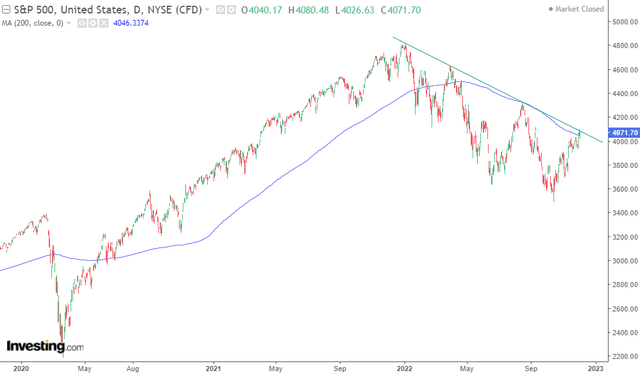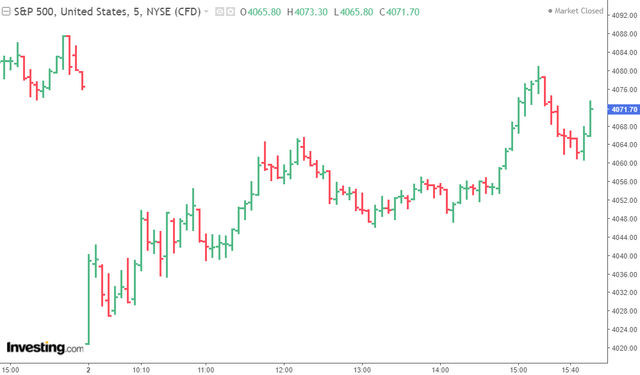baona/iStock via Getty Images
The recent rally in the S&P 500 Index (SP500) suggests that market sentiment is turning bullish as investors feel more confident that inflation will be tamed. More importantly, lingering concerns that the Federal Reserve may hike its Fed Funds Rate beyond 5% in 2023 have also begun to dissipate. We continue to see evidence supporting our view that inflation will moderate in 2023, while the U.S. economy will be resilient enough to accommodate higher interest rates without entering into a deep recession.
Technicals At A Crossroads
Our year-end price target of 4,200 for the S&P 500 is within reach, but the next few trading sessions will be crucial from a technical standpoint. As the accompanying chart shows, although the S&P 500 has successfully broken above its 200-day moving average (blue line), the index has stopped short of breaking above its trendline resistance (green line).
Investing.com, Stratos Capital Partners
While a decisive break above trendline resistance would send a clear signal to technical traders that momentum remains bullish, a pullback from here would mean we could see some selling pressure in the near term. Although the latter scenario could mean that our year-end target of 4,200 may not be achieved in time, we nonetheless maintain our bullish view on U.S. equities for 2023 and beyond.
Judging from last Friday’s intraday price action, we think the odds are slightly in favor of the bulls this week. The chart below shows the 5-minute bar intraday price action of the S&P 500 Index for 2 December 2022. The index gapped lower by about 1.2% during the start of the trading session after labor data showed payrolls surged by 263,000 in November, surpassing consensus estimates for a 200,000 increase. Average hourly earnings also came in above expectations, up 0.6% month-on-month and 5.1% year-on-year. However, as the trading session progressed, most of those losses were erased as bullish momentum drove the index higher throughout the day to close down just 0.1%.
We generally view intraday price action as indicating bullish momentum when markets open weak but finish strong towards the end of the trading session. Price action observed during the last trading day of the week is also more meaningful in determining the market direction in our view. This is because day traders tend to exit their positions at the end of each trading day and other short-term traders also do the same at the end of the trading week to avoid holding positions over the weekend.
Conversely, longer-term institutional investors tend to hold positions over longer periods of time and are thus generally agnostic to intraday price action. More importantly, given that the vast majority of the money in capital markets is controlled by institutional investors, the actions of this group are more impactful and meaningful in determining market direction over the medium-to-long term.
Market Timing Is Difficult, But Timing With Precision Is Just Foolish
Intraday price dynamics aside, we are intrigued by Morgan Stanley Chief U.S. Equity Strategist and Chief Investment Officer, Mike Wilson’s recent call for the S&P 500 Index to make a new low of around 3,000 to 3,300 in precisely the first four months of 2023.
In a recent interview with CNBC, Mike Wilson commented:
You should expect an S&P between 3,000 and 3,300 some time in probably the first four months of the year. That’s when we think the deacceleration on the revisions on the earnings side will kind of reach its crescendo. The bear market is not over. We’ve got significantly lower lows if our earnings forecast is correct.
Not just that, but Mike Wilson also recommends that investors do not sell just yet.
This is not a time to sell everything and run for the hills because that’s probably not until the earnings come down in January and February. I still think this tactical rally has legs into year end.
So, he is essentially calling for the current rally for the S&P 500 Index to continue through to the end of the year, and then equities will suddenly plunge by more than 20% within the first four months of 2023. We are not sure what kind of crystal ball he has at Morgan Stanley, but we think by making these precise calls on the equity market, he could be setting himself up for failure, or perhaps a career in stock market wizardry.
Unfortunately, such extreme calls are exactly what the financial media enjoys reporting the most. Not only does it attract the most readers, but it also feeds on the emotions of fear and anxiety among investors.
Stop Timing The Market, Ride The Market
We continue to advocate for disciplined long-term investing backed by evidence-based investing principles. Not only do we think that it is futile to time the market with precision, but we also argued in a previous article that financial market history has always favored the bulls.
For investors who hold a bullish view on the S&P 500 Index long-term but missed the market bottom in October, we think it is still better to catch the bull market a little late than to miss it completely. Missing the market bottom is not the be-all and end-all for long-term investors. For these investors, we propose to initiate a long position on the S&P 500 Index with a moderate position size first and to try to buy on the dips along the way.
Investors may also choose to invest periodically by dollar cost averaging over market cycles, adding to and building up their investment portfolio over time. Focusing more on stock selection to try and pick outperformers is also a way for investors who are late in the game to play catch-up with the benchmark.
On the other hand, staying out of the market could be the worst strategy for an investor. Not investing during a bear market could mean that long-term portfolio performance is permanently impaired, and playing catch-up too late risks having to take on excessive risk or being encouraged to use leverage.



Be the first to comment